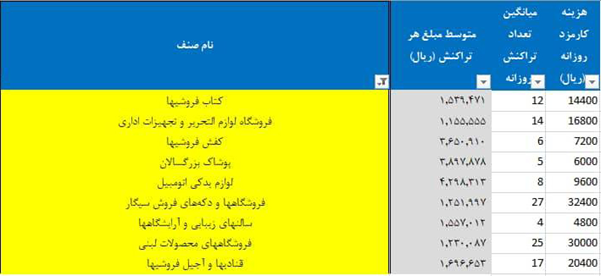Receiving a small fee from the owners of card readers

According to Iran Economistbased on the new guidelines of the fee system, which is set with the aim of establishing a balance and proportionality between the services received and bearing the costs of expanding and maintaining the infrastructure of the electronic payment network, for each of the departments involved in the card purchase transactions, such as the issuing bank, the receiving bank, and the receiving bank. Or the store that benefits from this service, a share is considered as a fee.
What is the fee paid by the acceptors (stores)?
According to this policy, stores or owners of card reader devices pay 120 tomans for each purchase transaction less than 600 thousand tomans and 2/10 thousand for each transaction, which is the ceiling This amount is also 4 thousand tomans.
If we want to calculate the amount of fees paid by each store on a daily basis, the average number of daily transactions of some guilds in the last year can be helpful. For example, the average number of daily transactions of bookstores last year was 12 transactions, the amounts of which are below 600 thousand Tomans. With this account, the fee paid by a bookstore per day will be 1440 Tomans.
Similarly, stationery and office equipment store with an average of 14 transactions per day is 1680 Tomans. This number is 720 Tomans for shoe stores with 6 transactions per day. Other cases are as described in the following table:
Even if we want to increase the daily transactions to 100 per day, the fee will be equivalent to 12 thousand Tomans.
On the other hand, for transactions with an amount higher than 600 thousand Tomans, if we consider the average amount of each transaction to be 2 million Tomans, the fee paid for each transaction will be equal to 400 Tomans, and if we consider the average number of daily transactions of these guilds, it is 20 transactions. The daily fee is equal to 8 thousand tomans.
In this regard, we must keep in mind that the payment limit for transactions above 600 thousand tomans is equivalent to 4 thousand tomans. In fact, for transactions of 20 million tomans and above, they pay 4 thousand tomans as a fee.
Based on this resolution, 62% of all terminals are expected to pay less than 2 thousand tomans per day.
The receiving bank bears the highest share in paying the fees for card purchase transactions
According to the new guidelines of the fee system, the receiving bank pays 5/10,000 of the amount of each transaction as a fee. For example, the receiving bank pays a fee of 300 tomans for a transaction of 600,000 tomans and 1,000 tomans for a transaction of 2 million tomans.
As can be seen, according to the reforms, the receiving bank has the highest share in paying the fees for card purchase transactions. The issuing bank also pays a fixed amount of 240 Rials for each transaction. Also, according to the new guidelines, the cardholder (customer) will not be charged a fee for buying a card.
The reform of the fee system is phased
According to the timetable for the implementation of this circular, the reform of the acceptors’ fee system will be implemented in stages, and transactions with high amounts will be implemented in priority. Also, until further notice, the acceptors of bakery and supermarket trades are exempted from paying fees and the share of these trades will continue to be paid by the acceptor bank.
The benefits obtained from the fees are spent on the renovation of infrastructure and network equipment so that the services provided continue and new lighting is available to the people. Also, with the implementation of these reforms, the failure of transactions and the occurrence of unsuccessful transactions, the formation of unhealthy and destructive competition in the business environment of payment companies, and the occurrence of violations such as fraudulent transactions will be prevented.


